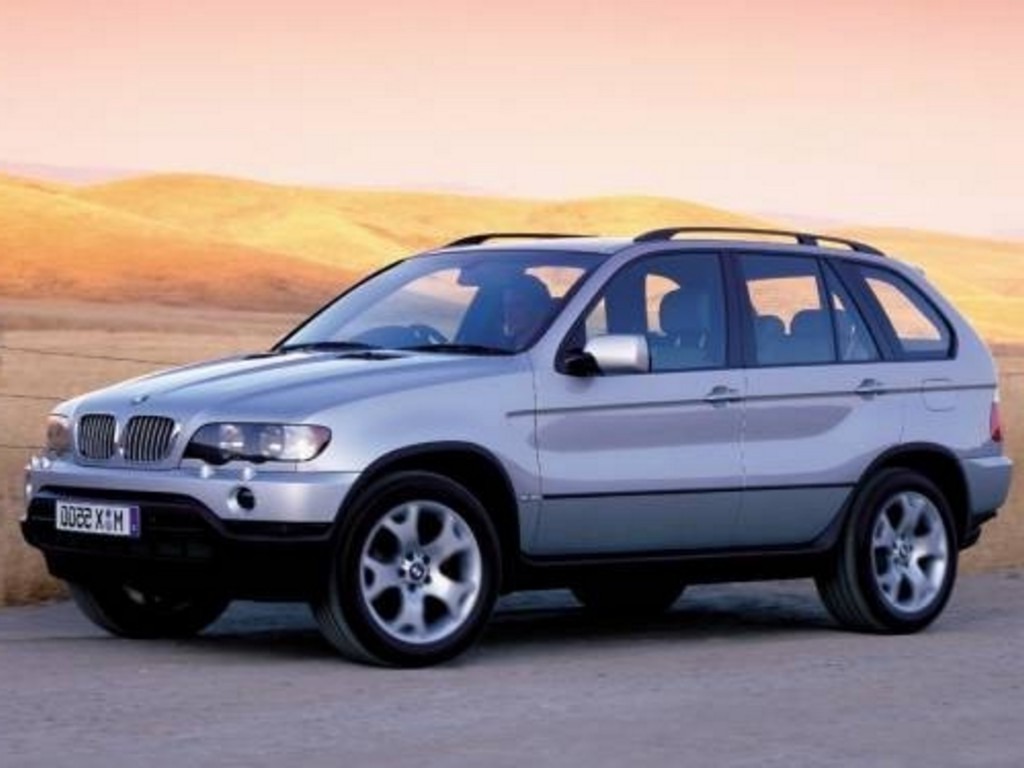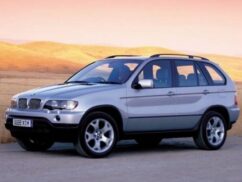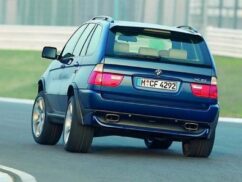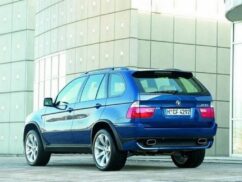1999 BMW X5

| The Good: – Head-turning looks – Sporty handling – Luxury interior |
The Bad: – Expensive to maintain – Small luggage area – Not a real dune-basher |
The X5 debuted in 1999, combining basic offroading capability with BMW levels of performance and luxury. Four years after its launch, the world’s first Sports Activity Vehicle still enjoys immense popularity. The X5 got a major facelift in 2004, along with a number of technical innovations and a bold new look.
There are character lines in the hood and meet the double kidney grille, which is a typical BMW design. The front of the car was revised right up to the A-pillar in 2004. The kidney-shaped air inlets had been redesigned; they had been enlarged and as a result they lend the X5 increased presence. Xenon low and high beam headlamps, standard on higher models, provide outstanding road illumination. At the rear, the tail-lights remained largely unchanged, except for a transparent look for 2004.
The BMW X5 was always more of a luxury highway cruiser than a mountain climber. It came with a good four-wheeldrive system in the earlier models, which was upgraded in 2004 and named xDrive. The X5 is the perfect vehicle for the enthusiast driver who wishes to combine excellent on-road handling and drive characteristics typical of BMW with a high seating position and the ability to master a wide range of driving situations, including basic off-roading. However, do not expect it to perform like a Land Cruiser on the toughest of dunes deep in the desert.
The best-selling X5 3.0i comes with a 3.0L, 231 hp and 300 Nm, in-line six-cylinder engine. In traditional BMW fashion, those who prefer to shift for themselves will find a manual transmission as standard equipment. A five-speed manual was standard, which was replaced by a six-speed in 2004.
The X5 4.4i also came with a 4.4L V8 engine. Earlier models got a 282 hp V8. The 4.4L V8 engine was upgraded to 320 horsepower in 2004 with VALVETRONIC valve control, Double VANOS and fully variable intake system has already used in the current BMW 7 Series. The 4.4L V8 generates 320 hp and 440 Nm, and accelerates from 0 to 100 kph in 7 seconds. The newer X5 4.4i was equipped with the new six-speed STEPTRONIC automatic transmission, while older models have a five-speed auto.
The top engine choice earlier was the 4.6L V8, producing 340 horsepower in the X5 4.6iS model introduced in 2002. This was replaced by the new-for-2004 X5 4.8iS featuring an enlarged version of the VALVETRONIC 4.4L engine from the X5 4.4i. This new 4.8L V8 power plant produces 360 hp and a massive 500 Nm of torque, and is coupled with a 6-speed STEPTRONIC automatic transmission. This abundant power is driven through W-rated performance tires.
In order to make the most of the new powertrain updates in 2004, BMW’s newest all-wheel drive system helps to ensure optimum performance in all driving situations. The xDrive intelligent all-wheel-drive system was a completely new design in 2004, and it set new standards among all-wheel drive vehicles for road holding and agility. The xDrive system performs stepless and variable distribution of drive forces between the front and rear wheels at an unprecedented speed.
xDrive reacts faster than other systems because it is able to think further in advance. It not only makes use of the information obtained from the wheel sensors, which signal when any of the wheels are spinning, but also data collected from Dynamic Stability Control (DSC) system sensors. Yaw rate, the information regarding rotational movement of the vehicle itself, and the steering wheel position both supply important data concerning the current situation. This enables xDrive to distribute drive power ideally and at any given moment between the front and rear wheels, for instance during cornering, thereby significantly minimizing chances of skidding.
In addition to the clear increase in agility and driving enjoyment, xDrive also provides great safety benefits. As a result of its fast reaction time, the new system provides greatly improved road holding characteristics. Whether the driving surface is rough or smooth, it only takes a few milliseconds once friction is lost between the wheel and the road surface for the drive forces to be redistributed to the wheels that still have traction. The electronically controlled multi-disk clutch loses no time and reacts immediately. Thanks to xDrive, starting off on a slippery iced surface or climbing steep uphill slopes proves to be a simple exercise for the new X5.
In hard driving, all X5 models, old or new, perform very much like a basic sports sedan. Cornering abilities on the road far exceed those of competitors like the Mercedes-Benz M-Class, Toyota Land Cruiser and Range Rover, even beating more traditional cars like the Toyota Camry. This four-wheel-drive system, however, cannot overcome the X5’s offroading deficiencies, as the entire undercarriage can be ripped apart by a tall enough rock. The X5 is more of a soft-roader than an off-roader.
At 100 kph, the X5 is just coming into its own. The fully independent, aluminum-intensive suspension, which feels firm at slow speeds, is stable on the highway, and the brakes will kill speed in a short time, repeatedly. Large 14-inch front and 12.8-inch rear disc brakes bring BMWs most potent SAV to a quick and sure-footed stop. The automatic and manual gearboxes shift like any BMW, which is quite well.
As far as safety is concerned, the new X5 again scores extra points on a buyer’s report card. The X5 has successfully proven its passive safety qualities in one of the most stringent crash tests in the world. The BMW Sports Activity Vehicle was the first so-called “Large Off-Roader” to be awarded a score of five stars in the Euro NCAP Test. For those who use the special performance features of the X5 for towing, there is a further unique safety feature – the trailer stabilization control of the new X5, which prevents dangerous rocking movements. Additional sensors that are able to recognize potentially dangerous pendulum motions are included with the DSC system, which can apply braking forces to help return the trailer to safe motion.
The long list of standard features include rain-sensing windshield wipers and adaptive headlights with automatic headlight control and self-dimming mirrors. Also included with this package are adjustable and heated rear seats, a ski bag, and a digital compass mirror. For the audiophile, an in-dash CD player is included as is a 6-CD changer. The interior is luxurious yet simple in typical BMW style, but the luggage area at the back could have been a bit bigger, considering the astronomical prices of every X5 model.
The BMW X5 has proven to be exceptionally reliable. Some electrical faults may crop up, such as power door lock issues or a malfunctioning computer. Just be on the look-out for these. Also be sure to review the service history, as the engine is indestructible only if maintained properly. Resale are above average, since it is one of BMW’s more popular models. You could probably get an older 4.4i for the price of a 3.0i from the same year, as the more economical 3.0L model is more sought after.
| Price Range: Dh 130,000-195,000 Current Model Introduced in: Body Styles: Engines: Transmissions: Setup: Suspension: |
Brakes: Front: discs Rear: discs Curb Weight: Length: Wheelbase: Top Speed: Test Acceleration 0-100 kph: Observed Test Fuel Economy: |












There are no comments. Be the first!